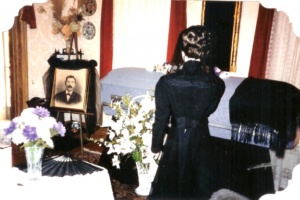Mourning in America

The Victorians had superstitious beliefs about the dead. When someone died in a home, the clocks were stopped at the time of death or you would have bad luck. Mirrors were covered so that you could not look in and see the soul of the dead person. Black ribbons were put on outside doors to let people know the family was mourning and they should not be bothered by visitors. People who lived on busy city streets often put straw on the street in front of the house to dull the sound of horses’ feet. Cabinet makers were hired to build a proper sized wooden coffin. In Palatine, Carl Danielsen was the cabinet maker who did that job. His son, Frank, became Palatine’s first mortician with a license. Wakes were held in the home, in the parlor. Wreaths and crosses of flowers were sent to the home. Ads were placed in the newspaper so people would know when to come and pay respects to the family and when/where the funeral would be held as is still done today. Men whose close relatives died wore black armbands for at least three months. Women, of course, had more severe restrictions. They were socially required to wear black mourning clothes from six months to a year for close relatives. Wives had to wear mourning clothes for two or three years. The first year was full mourning, that is dull black cloth, often crape, with no other color; no shiny cloth or jewelry. Jet was a common mourning jewelry made of a soft black rock or gutta percha. The exception here was memorial jewelry that held cuttings of the dead person’s hair. Also included were black shoes & stockings, black gloves, black purses, black fans and black aprons. Some even wore black undergarments or at least black ribbon in their old white ones. After a year, shiny black cloth could be worn with white trims like cuffs and collars. French jet jewelry was appropriate; that is black glass. The third year, not usually followed in rural areas, was a switch to gray or lavender colors. A man could remarry after three months. Not a widow; she must wait a full year before marrying and should never wear white. A woman must quickly get black clothes before the wake so these were the first ready made things sold in stores If you could not afford to buy new clothes you dyed the ones you had black.Queen Victoria’s lifelong mourning of Prince Albert and America’s Civil War brought all of these customs fully blown to all classes of people.